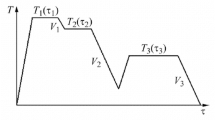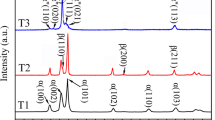The paper examines the wear mechanisms of the VT-3 titanium alloy and TBKhN composite in fretting corrosion conditions. It is shown that the oxide film formed on the titanium alloy during friction fails and further wear occurs on the juvenile surface. This leads to seizure and removal of the material from the surface, indicating that adhesive wear prevails in friction of the titanium alloy. The TBKhN40 composite is characterized by oxidative wear. The oxide film with grain-oriented fine structure forms in the friction process through selective oxidation of refractory and metal components.







Similar content being viewed by others
References
B. B. Chechulin, S. S. Ushkov, I. N. Razgulyaeva, and V. N. Gol’dfain, Titanium Alloys in Mechanical Engineering [in Russian], Mashinostroenie, Leningrad (1977), p. 248.
A. M. Sulima and M. I. Evstigneev, Quality of the Surface Layer and Fatigue Strength of Parts Made of Heat-Resistant and Titanium Alloys [in Russian], Mashinostroenie, Moscow (1974), p. 255.
O. I. Dukhota, M. V. Kindrachuk, and V. F. Labunets, “Challenges in using titanium alloys in aviation friction units,” in: Issues of Friction and Wearing (Collected Scientific and Technical Papers) [in Ukrainian], Vol. 1, Issue 49, Nats. Aviat. Univ., Kiev (2008), pp. 14–26.
I. V. Gorynin and B. B. Chechulin, Titanium in Mechanical Engineering [in Russian], Mashinostroenie, Moscow (1990), p. 400.
N. M. Pul’tsin, Titanium Alloys and Their Applications in Mechanical Engineering [in Russian], Mashgiz, Moscow–Leningrad (1962), p. 168.
A. S. Bai, D. I. Lainer, E. N. Slesareva, and M. I. Tsypin, Oxidation of Titanium and Its Alloys [in Russian], Metallurgiya, Moscow (1970), p. 320.
A. P. Umanskii, E. P. Pugachevskaya, and V. P. Konoval, “Studying the interaction of titanium–chromium diborides with Ni–Cr alloys,” Adgez. Met. Alloys, Issue 41, 44–52 (2008).
R. F. Voitovich and É. I. Golovko, High-Temperature Oxidation of Titanium and Its Alloys [in Russian], Naukova Dumka, Kiev (1984), p. 256.
V. B. Lazarev, V. V. Sobolev, and I. M. Shaplygin, Chemical and Physical Properties of Simple Metal Oxides [in Russian], Nauka, Moscow (1983), p. 239.
Acknowledgements
The authors are grateful to Professor V. A. Lavrenko for assistance in preparing the paper.
Author information
Authors and Affiliations
Corresponding author
Additional information
Translated from Poroshkovaya Metallurgiya, Vol. 51, No. 5–6 (485), pp. 41–48, 2012.
Rights and permissions
About this article
Cite this article
Pugachevskaya, E.A., Umanskii, A.P. & Chuprov, S.S. Wear mechanisms of the VT-3 titanium alloy and titanium–chromium diboride composite under fretting corrosion. Powder Metall Met Ceram 51, 282–288 (2012). https://doi.org/10.1007/s11106-012-9429-y
Received:
Published:
Issue Date:
DOI: https://doi.org/10.1007/s11106-012-9429-y




